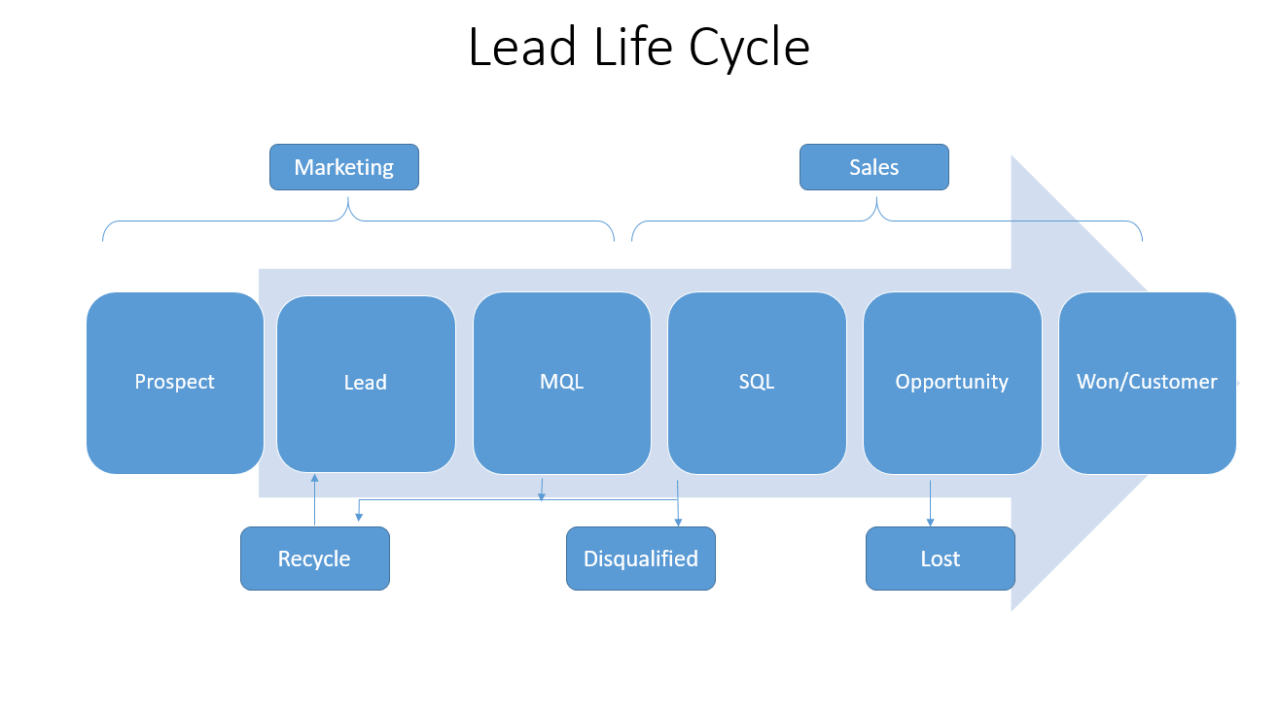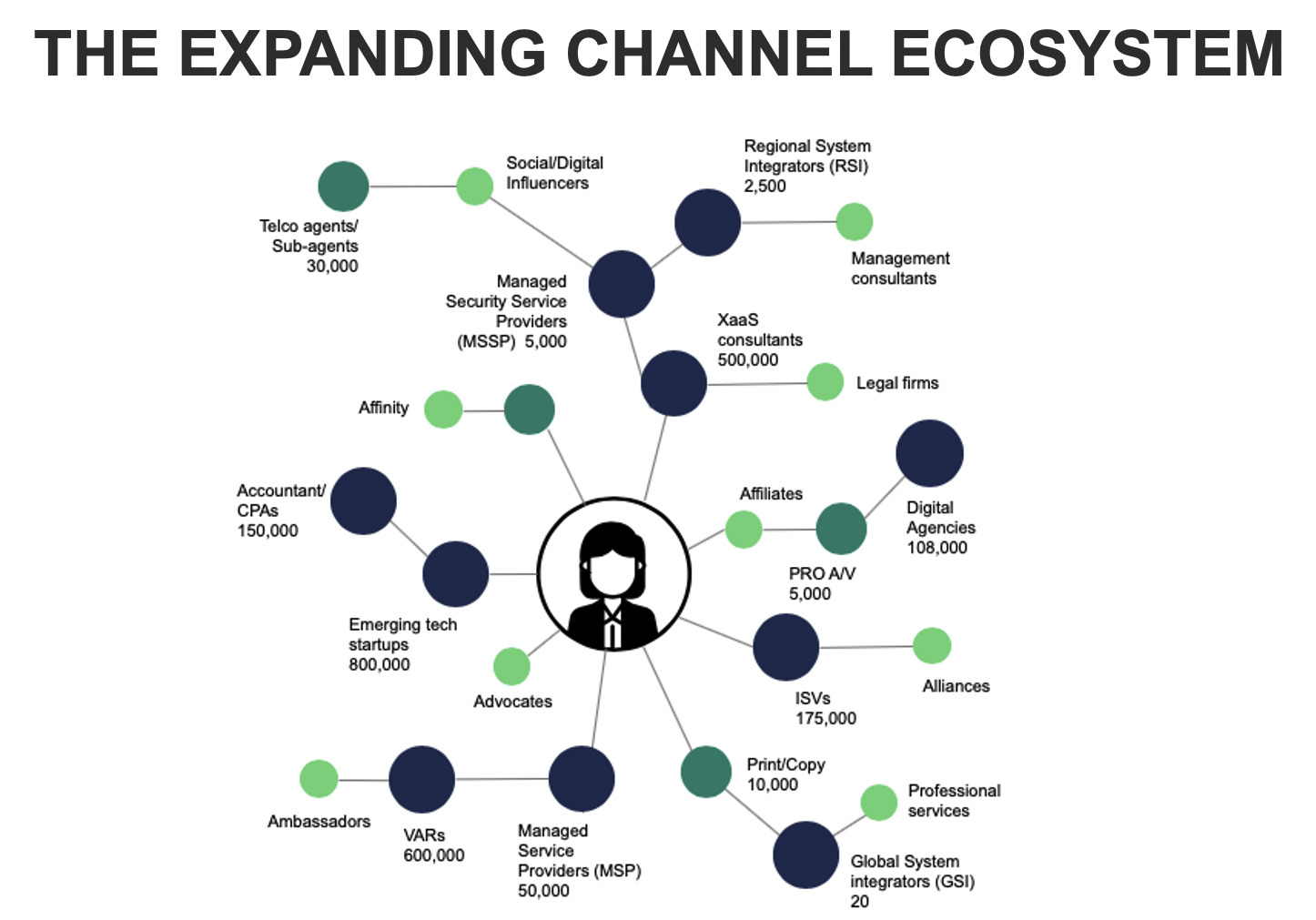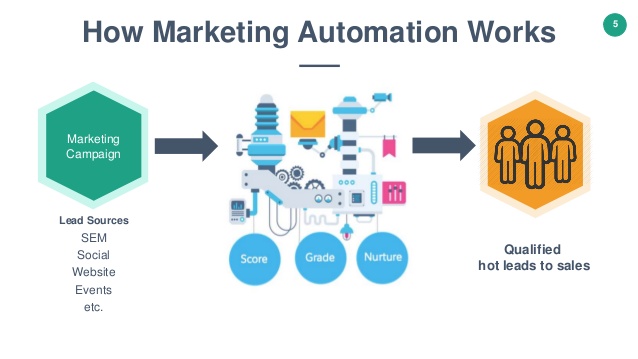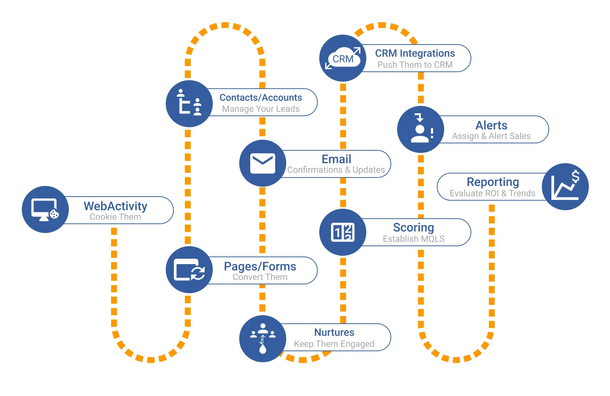Automated Marketing Lead Lifecycle Management in a Business-to-Business Partner Ecosystem
Discovering and engaging with new leads is crucial for any B2B company. This is the first step in your marketing and sales process, yet some businesses struggle to keep leads from falling through the cracks. Creating an automated marketing lead lifecycle can help your team excel in lead management.
This cycle will help your marketing and sales department define the process for lead hand-offs and facilitate the creation of a symbiotic relationship between the two teams. The lead flow process will also help ensure qualified leads are getting to the right employees, and other leads are being nurtured until they’re ready to convert.
Taking advantage of an automated lifecycle can help lift the load that lead management puts on your team. Qualifying, nurturing and pushing leads through the pipeline takes time and resources, but utilizing your tech stack can lessen the burden.
Keep reading or use the links below to “jump ahead”:
- What Is a Lead Lifecycle?
- The Five Stages of Lead Lifecycle Management
- Understanding the Difference Between a Marketing Qualified Lead & a Sales Qualified Lead
- What Is a Marketing Service-Level Agreement?
- Automated Sales Lead Management
- LeadBoxer’s B2B Sales Ecosystem
- Key Takeaways
What Is a Lead Lifecycle?
Simply put, the lead lifecycle is the journey your prospects take through the marketing and sales stages. This process helps manage the customer experience by defining what stages your leads need to pass through before the deal is closed. The lead lifecycle sets rules for your teams to follow so prospects are nurtured and passed through the stages at the correct time.
This seems like a simple concept, but it requires buy-in from all departments as well as proper execution. Done correctly, your lead lifecycle can ensure no prospects slip through the cracks, generating more sales.
The lead lifecycle creates a process to manage prospects from the start to finish of their customer journey. This plays a major role in improving the overall quality of leads that are being transitioned to the sales funnel. By implementing a standard lead scoring system, your marketing department can gain valuable insight into each lead’s level of interest.
This process helps determine the difference between a new prospect, a marketing-qualified lead and a sales-qualified lead. This allows your sales team to spend their efforts on customers who are ready to buy, while marketing is able to allocate resources to leads who may need more time. Sales activities can be used to produce revenue rather than spending time on cold outreach.
Once a prospect has been identified, marketing begins nurturing the relationship, which helps qualify the lead. After gauging the level of interest and readiness to buy, the lead is either handed off to sales or recycled back into the marketing funnel.
For leads that are not quite sales ready, your marketing department can begin fostering a stronger relationship through advertisements, email campaigns and in-depth product knowledge. The lead lifecycle also leaves room for valuable feedback to reach your departments. Marketing is able to see which campaigns work well and make adjustments when content isn’t producing the desired results.
Proper lead qualification also helps segment your prospects, which allows your team to engage with targeted audiences. This means your resources can be used on leads where they will gain the most value.
By having a defined lead lifecycle, your company makes sure no lead gets left behind while improving overall lead quality. It will help your company create a loop from sales to marketing, which helps your marketing department tighten up their efforts.
By qualifying leads, your sales team can provide insight and let your marketing department know which channels are producing the best customers. This allows your company to better allocate resources as well as strengthen any areas that are falling behind.
The Five Stages of Lead Lifecycle Management

When implementing a lead management strategy into your company, the first step should be defining and understanding what a lead is for your team. While this seems like a basic concept, it is crucial to avoid vague descriptions or loose definitions.
This helps determine at which stage a prospect can be considered sales-qualified, as well as helps place all customers into the right stage of their lifecycle. There are five stages that can help your team create a standard process for the sales funnel.
Marketing Inquiry (MI)
Not quite a lead yet, a marketing inquiry is the first introduction for many prospects. This is when a contact may enter the lifecycle but needs to be nurtured before moving any further in the process.
For example, this type of prospect may come from a website form, webinar attendee, content download or email campaign. They will have most likely engaged with your company but not yet requested further follow-up from a sales representative.
As nurturing begins to take place, a lead score can be determined for the prospect. MIs are not ready to be passed off to sales, and should be handled directly by the marketing department.
Marketing Qualified Lead (MQL)
Further along in the process, an MQL has shown interest in buying and a need for your product. This is someone who is engaged with your content and shows the ability to convert to a sale. Most likely, an MQL will have asked for a follow up from the sales team, or reached out to discuss the problem their business is facing.
Most importantly, an MQL will have provided contact details including their full name, phone number, email, company name, location and specific product needs. This helps determine the transition from marketing to sales.
Sales Accepted Lead (SAL)
This is the stage where the sales team should do their own vetting to determine if the lead is truly ready for their efforts. This means reaching out, verifying that the contact information is correct, and asking what type of solutions the client is seeking.
This stage helps create a smooth relationship between your sales and marketing departments. For the leads that pass their qualifications, sales will be able to start their leg of the customer journey. However, for the ones disqualified or sent back to marketing for additional nurturing, this provides the sales team with an opportunity to give feedback.
By having a defined process that allows these conversations to take place, marketing will be able to streamline their efforts for MQLs and improve the overall quality of leads that are being handed off.
Sales Qualified Lead (SQL)
When it’s determined that a lead has the need for your product, a willingness to purchase and a timeline in mind, the sales team can label them an SQL. This moves the lead toward the finish line and helps your sales team get closer to completing the sale.
Closed
The last stage in the lifecycle is a completed sale. When the process works correctly, your sales team will have guided the client across the finish line, resulting in a successful conversion.
When a sale fails to go through, there are multiple ways to define a disqualified lead. If the prospect is a bad fit or indicates they will not buy your product, the lead should be disqualified and removed from the lifecycle. However, if the lead determines they just need more time before making a purchase, they can be recycled back to marketing to further strengthen the customer relationship.
Understanding the Difference Between Marketing Qualified Leads & Sales Qualified Leads
Because the lead lifecycle process is designed to help improve the overall quality of your leads, it’s crucial to understand the difference between marketing and sales qualifications. This will help align your departments and ensure all employees are working toward the same end goal—increasing sales conversion rates.
The marketing department is usually the first point of contact for all prospects. Whether the lead is generated through website traffic, downloaded content or social media engagement, their first impression is affected by the content they’re consuming.
Immediately after the initial contact is made, marketing funnels these prospects into the lifecycle to begin nurturing and qualifying the lead.
A Marketing Qualified Lead (MQL) is defined by their need and the contact information gathered. Most likely, these prospects have engaged with campaigns, expressed interest in your product to solve a specific business issue and provided valid contact information.
In comparison, a Sales Qualified Lead (SQL) has already been determined as a potential customer with buying capacity. This means your product is seen as a potential solution for their business, and they have begun their journey through the sales funnel. SQLs are further along in the buying process compared to MQLs.
SQLs will have a determined budget and some understanding of how your product fits into their business model. They will also have a timeline for their purchase, which helps your sales team determine the validity of the lead.
Having both teams understand the difference between MQLs and SQLs creates a smooth pipeline between departments. Your marketing resources will be allocated to those who need more time in their journey, while sales efforts can go directly to closing deals.
What Is a Marketing Service-Level Agreement?
To help close the gap and avoid silos between sales and marketing teams, a service level agreement (SLA) can be used to align goals and measure progress. Traditionally, an SLA establishes deliverables between a business and its clients, but it can be used for internal operations as well.
There are three common types of SLAs:
- Customer Service SLA
- Internal Service SLA
- Multi-Level SLA
A customer service SLA helps create an agreement of services between vendors and specific clients. For example, this could include the type of product, date of delivery, and point of contact for confirmation.
Internal service SLAs operate only within one company, typically between two departments. This is a great way to create processes, share goals and report on each team’s efforts.
Lastly, a multi-level SLA can work for multiple departments to ensure all teams are working toward the same end goal. Rather than working solely between sales and marketing, this SLA may loop in customer retention or quality control teams.
Utilizing an SLA can ensure your lead lifecycle process is working across the board. This specific SLA will help create guidelines that qualify the hand-off of leads from marketing to sales. It can determine the process for notifying and assigning new leads to the sales team.
The SLA can help lay out appropriate procedures for sales to follow up on MQLs. The agreement can be used to create a rejection process if sales determines leads are unqualified.
To get started, determine numerical values for marketing and sales goals. Sales will be set by their quotas, while marketing can base its numbers around metrics that measure how resources are being used to create revenue.
Assigning numbers and key performance indicators (KPIs) that both teams are expected to meet establishes a standard of accountability across both departments. Numerical values can also help marketing understand the mindset of quote-driven salespeople.
Next, create a system for tracking and reporting these initiatives. This will help both teams measure their successes and evaluate which areas could use improvement.
Lastly, create a system that holds teams accountable to their goals. This means determining a process for what will happen if a department fails to meet its expectations including a plan for making up lost revenue.
To ensure both departments are holding up their end of the deal, encourage open communication and list the best ways to contact each team.
Automated Sales Lead Management
Automating your lead lifecycle can help your company remain competitive in the B2B industry. Lifting the load of repetitive daily tasks and allowing automation to take over data cleansing frees up time and resources for your teams to flex their creativity. In our increasingly digital world, utilizing tech stacks and plugging into the B2B ecosystem gives your company an edge.
The B2B ecosystem refers to a digital network that connects vendors, customers and developers across areas. Going one step further, the business-to-business partner ecosystem brings together similar businesses, typically ones that share ideal client profiles and territories. These partnerships help drive innovation and produce higher Return on Investment (ROI).

Building these partnerships and taking advantage of collaboration helps your company get ahead in the industry. Integration strategy is one way to utilize the ecosystem. Creating Application Programming Interfaces (APIs) allows companies to form partnerships and seamlessly integrate tech stacks.
APIs allow businesses to connect technologies and further automate time-consuming processes. This integration also promotes quicker communication and accurate data transfer between internal teams.
For example, automated lead management software can integrate with your Customer Relationship Management (CRM) so sales can see updated information on the status of lead engagement. This also allows marketing teams to see the sales process, enabling them to encourage follow up with MQLs as needed.
By utilizing this integration strategy, business processes can be improved and user ability can be extended. Throughout your company’s personal ecosystem, digital transformation can play a huge role in your company’s overall success. Embracing automation can help connect your departments and create lasting partnerships with other B2B companies.
Automated lead management platforms like Leadboxer do more than simply identify prospects and store contact information. Leadboxer helps capture data from website or content engagement, score leads and segment target audiences to maximize your marketing outreach.
Why Automation Is Key to Success
Manually tracking sales leads through the lifecycle is a big undertaking for most marketing teams. Human error can account for promising leads slipping through the cracks.
Automation is a game-changer!
Sales conversions are the ultimate goal of lead generation. Allowing software to take over repetitive tasks so more time can be spent moving leads through the sales funnel is the most efficient way to increase your ROI and productivity.
An automated workflow helps align team goals and ensures processes are followed. With lead management software, prospects can be segmented for marketing to easily nurture. Leads can be automatically assigned for outreach, and engagement data can be pushed through to your CRM.
Most importantly, automated lead management can fine-tune the qualifying process. Leadboxer uses data gathered based on behavior and client profiles. The platform also includes a scoring algorithm to help your marketing and sales teams determine the validity of each prospect.
Rather than wasting effort with old contact information, automated workflows ensure your team is using the most up-to-date data available. Automatically gathering information and contact details shortens the time between lead introduction and sales follow-up. It also helps your marketing team nurture relationships and determine which leads need to receive additional promotional content.
This innovative software can also streamline the notification system between departments, which helps lessen the time that leads go without being responded to and nurtured. Delays can easily cost your business sales.
With notifications, sales can be ready to reach out to new leads as soon as they arrive in the CRM, and marketing can segment prospects into targeted audience outreach almost immediately.
Leadboxer’s B2B Sales Ecosystem
Innovation and collaboration are driving the B2B industry. Through the business-to-business ecosystem, companies are able to expand their abilities and become competitive leaders while working more efficiently.
Enterprise platform integration is a trending strategy that has the ability to reshape the B2B industry. Driving growth and encouraging partnerships is helping boost business development.
An integration platform enables customers to combine their tech stacks and data to optimize workflows. Global key players for this strategy include Microsoft, Informatica, Dell Boomi and others.
Leadboxer also integrates with many applications to form an important B2B sales ecosystem that helps companies boost the performance of their current tech stack.
Leadboxer integrations include:
- Pipedrive
- Salesforce
- Google Analytics
- WordPress
- Slack
- HubSpot CRM
- Microsoft Outlook
- Gmail
- Zapier
- Drupal
- SugarSell
- Segment.com
- …
As a lead management software, Leadboxer works to make marketing and sales easier for B2B companies. Through lead generation, qualifying, scoring and automated workflows, the software is a staple for companies who need help with their lead lifecycle.
Through partnership and integration, your company is able to transfer data between software platforms and streamline communication with internal teams. The use of lead management software like Leadboxer automates the lead lifecycle and eliminates any bottlenecks between marketing and sales teams.
Key Takeaways
Establishing a lead lifecycle and defining qualified leads is an important first step to excelling in your lead management strategy. By aligning the goals of sales and marketing and including an automated process for lead management, your company can begin working with the most qualified leads available.
Understanding the difference between marketing-qualified leads and sales-qualified leads can help your teams make sure prospects are interacting with the right resources. By defining what your team considers an SQL, marketing can make sure these contacts are being delivered to salespeople for immediate follow-up. This will also lessen the amount of rejection of MQLs by the sales team since your marketing department will have clear guidelines on proper lead qualification.
Utilizing a marketing service-level agreement can help organize your internal goals and get multiple departments on the same page. It is crucial for marketing and sales to be aligned in their efforts, and a SLA helps hold both teams accountable. This strategy lays out what each department needs for success and will help increase accountability and boost overall ROI.
Automated marketing lead lifecycle management helps free up resources from your departments and allows software to do the heavy lifting in your lead generation plan. This also helps your company become part of the B2B ecosystem through enterprise platform integration.
Taking advantage of the B2B partner ecosystem encourages innovation and collaboration. It also allows your company to maximize the usage of its tech stack.
Understanding and implementing a successful lead lifecycle management process can lead to higher ROI for your B2B company. Automation helps align goals, eliminate silos and clean data for a better overall lead lifecycle.
To get started with lead management automation with multiple application integrations, check out this free LeadBoxer trial!



